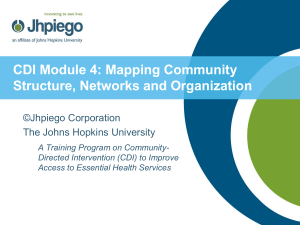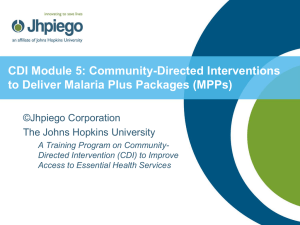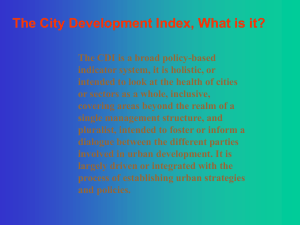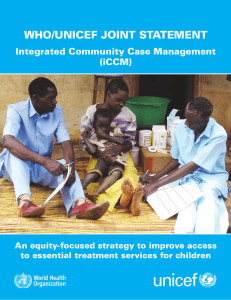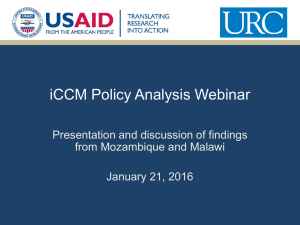Overview of iCCM Strategy through Community
advertisement
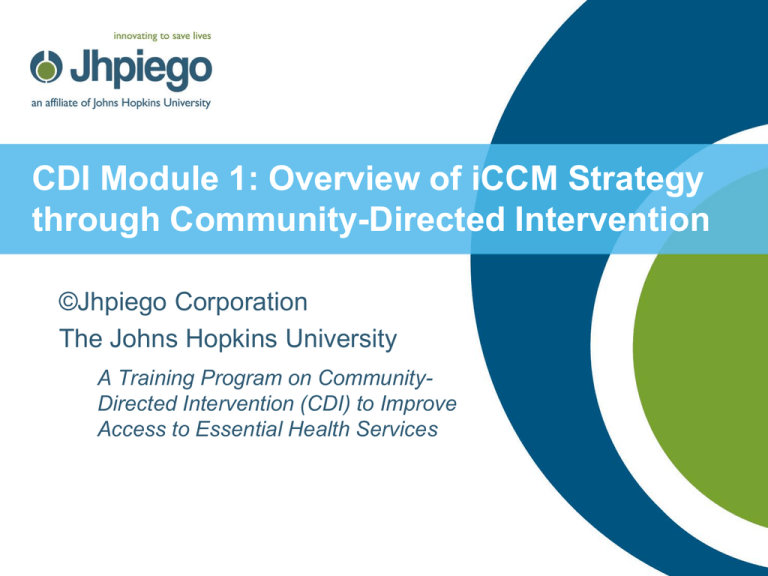
CDI Module 1: Overview of iCCM Strategy through Community-Directed Intervention ©Jhpiego Corporation The Johns Hopkins University A Training Program on CommunityDirected Intervention (CDI) to Improve Access to Essential Health Services Welcome and Overview Our goal in health care is to ensure that all communities—through their full participation— have access to simple but scientifically sound lifesaving preventive and treatment services We have organized a series of 18 training modules for a five- or six-day workshop that can be used to deliver technical content: On case management and prevention of common health problems Through a community-directed delivery mechanism 2 Background These modules build on: Jhpiego field experience in delivering malaria services, through community effort, including: Malaria in pregnancy services Illness case management The 16+ years of effort by the African Program for Onchocerciasis Control and the Special Program for Research and Training in Tropical Diseases of the World Health Organization and its partners This approach can be adapted for many locally relevant health issues 3 Some Acronyms We Will Use Interventions ACT: artemisinin-based combination therapy ANC: antenatal care CDI: community-directed intervention CDT: community-directed treatment DOT: direct observation of treatment DOTS: directly observed treatment, short course (for TB) HMM: home management of malaria iCCM: integrated community case management IPTp: intermittent preventive treatment in pregnancy ITN: insecticide-treated net LLIN: long-lasting insecticide-treated net ORS: oral rehydration solution ORT: oral rehydration therapy RDT: rapid diagnostic test 4 Some More Acronyms We Will Use Interveners CBO: community-based organization CDD: community-directed distributor CHA: community health agent CHW: community health worker CIMCI: community-integrated managers of childhood illness CORP: community-oriented resource person NGO: nongovernmental organization PMV: patent medicine vendor RMCG: role model caregiver VHW: village health worker (volunteer) 5 Workshop Objectives and Outcomes This workshop is action-oriented and is based on work by CDI implementation teams Team work will result in two documents: 1. A strategy development document 2. An implementation planning document 6 Workshop Outcomes: Strategy Development Document The strategy development document will: Review CDT scope, program plans and activities to date Review national guidelines on iCCM/HMM Set your program’s CDT/iCCM goals, targets, objectives for each team Outline key technical and management strategies Determine measurement and monitoring mechanisms 7 Workshop Outcomes: Implementation Planning Document The implementation planning document will develop an overall implementation plan as well as specific components, including: A training guide and plan for health workers, CBOs, NGOs, PMVs, traditional healers, traditional birth attendants and village development workers A commodity procurement, supply and management plan A supervision checklist A monitoring and evaluation (M&E) plan 8 Outline of Agenda: Day 1 Morning Welcome and introductions Overview, objectives, agenda Ground rules Expectations of workshop on strategy for implementing integrated community case management through community-directed treatment Overview of program context 9 Outline of Agenda: Day 1 Morning (Part 2) Organize learners to achieve workshop outcomes by: Sharing and explaining templates for developing: A strategy An implementation plan Taking Stock Sharing work to date by teams Identifying gaps 10 Outline of Agenda: Day 1 Afternoon Review national guidelines on: Community health volunteers and their roles iCCM and HMM as a basis for strategy Present modules 2–4 on CDI/CDT processes: What is CDI and how is it applied to malaria? – Success stories Working with the health system Working with the community Training community volunteers 11 Overview of the Larger Project/Program Provide an overview of: National efforts and community interventions we will focus on this week The week’s agenda Introduce: Working teams (state, regional, district, etc.) and facilitators who will assist them 12 integrated Community Case Management iCCM provides high-impact interventions on a large scale, at reasonable cost, and thus, has measurable, attributable effects on: Treatment of common illnesses Reproductive health Safe motherhood Child health interventions such as immunization and vitamin A Each project chooses an appropriate mix of such interventions. 13 Community-Directed Intervention CDI provides an ideal delivery mechanism for iCCM services As we will discuss in Module 2, CDI involves the community in organizing its own service delivery The health system enhances the capacity of the community to help itself through training, supportive supervision and commodity supplies 14 Malaria High-Impact Interventions Malaria provides a good example of interventions the community can deliver: IPTp with sulfadoxine-pyrimethamine (SP) LLINs (distribution and promotion of use) Prompt diagnosis, appropriate treatment with: RDTs ACT medicines And as we achieve impact and move toward elimination, the community can undertake surveillance 15 Key Components of Your Strategy Document Background: status of health issues (malaria, pneumonia, etc.) in your geographic area Goals, targets, objectives Partnership: stakeholders and leadership Community taking responsibility through their CDDs/CORPs iCCM facilitation teams from the health service Technical interventions to be delivered by the community and its volunteers (e.g., ACTs, LLINs, ORT, etc.) 16 Strategy Addresses the Management of Interventions Supply chain management Supportive management of illnesses in the community Supportive supervision and quality assurance Advocacy, community involvement and mobilization Monitoring, surveillance and evaluation Training community volunteers, leaders, organizations 17 Implementation Plan Activities, Date steps planned Goal 1: (e.g., M&E) Responsible person Resources Date of completion Goal 2: (e.g., Procurement) Goal 3: (e.g., Training) 18 COMMENTS AND QUESTIONS Followed by the initial meeting of teams … 19

